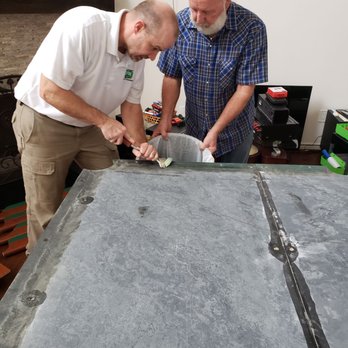When you’re in the market for a pre-owned pool table, knowledge is power. Before making a purchase, it’s essential to understand the significant differences between slate and non-slate tables. Here’s a deep dive into why slate tables have a superior edge over non-slate options.
What is Pool Table Slate?
Pool table slate is a fine-grained rock used as the playing surface for quality billiard tables. The rock is meticulously milled and flattened to ensure an impeccable and even playing surface. Think of it as the foundation of your gameplay experience.
Weight and Levelness: The Unbeatable Combination
Slate is the gold standard for pool tables, and for a good reason. Its natural weight ensures the table remains level over extended periods. This heavyweight ensures the table settles firmly on its surface, whether that’s carpet, hardwood, or concrete.
This weight offers a dual advantage:
- Settling: A heavy table (around 750 pounds or more) is less likely to warp over time. Its sheer weight ensures it settles firmly and remains level.
- Stability: The table’s heft means it won’t easily shift or move even if a player bumps or leans against it.
Beware the “Slate-Like” Imitations
Some manufacturers offer tables with a wooden or manufactured playing surface as a cost-effective alternative, claiming it’s as reliable as slate. However, these alternatives lack the inherent benefits of slate. Even some slate tables, where the slate thickness is compromised to cut costs, don’t measure up to the standard one-inch slate thickness. This one-inch thickness is what pool enthusiasts should aim for, whether they’re buying a new or pre-owned table.
How to Identify Genuine Slate?
If you’re shopping for a pre-owned table, here’s how to determine if it’s genuine slate:
- Measure the Thickness: Check the thickness of the playing surface, especially where it enters a pocket.
- Visual and Physical Inspection: Peek underneath the table. Slate will typically appear as a dark gray rock with a marble-like texture. Knocking on it should produce a solid sound.
- Manufacturer Labels: Some brands, like Brunswick, produce their slate and often label their products.
Hiring Professionals is Key
Genuine slate tables usually consist of three separate slate sections, which need to be perfectly aligned to provide a seamless playing surface. Achieving this precision is not a DIY job. Professional pool table mechanics use sterit levels with accuracy within 1/100th of an inch. Therefore, hiring a professional mover to break down, transport, and set up a slate table is crucial.
In Conclusion
When buying a pool table, your primary aim is to ensure quality and consistent gameplay. A genuine slate surface guarantees this. Consider this blog your roadmap to making an informed choice.
Call to Action: For expert advice or assistance, think of DFW Billiard Professionals for your next table move or to explore certified pre-owned table options. Dive into a world of precision, quality, and unmatched gameplay.
Why Slate Pool Tables Outshine Non-Slate Options
When you’re in the market for a pre-owned pool table, knowledge is power. Before making a purchase, it’s essential to understand the significant differences between slate and non-slate tables. Here’s a deep dive into why slate tables have a superior edge over non-slate options.
What is Pool Table Slate?
Pool table slate is a fine-grained rock used as the playing surface for quality billiard tables. The rock is meticulously milled and flattened to ensure an impeccable and even playing surface. Think of it as the foundation of your gameplay experience.
Weight and Levelness: The Unbeatable Combination
Slate is the gold standard for pool tables, and for a good reason. Its natural weight ensures the table remains level over extended periods. This heavyweight ensures the table settles firmly on its surface, whether that’s carpet, hardwood, or concrete.
This weight offers a dual advantage:
- Settling: A heavy table (around 750 pounds or more) is less likely to warp over time. Its sheer weight ensures it settles firmly and remains level.
- Stability: The table’s heft means it won’t easily shift or move even if a player bumps or leans against it.
Beware the “Slate-Like” Imitations
Some manufacturers offer tables with a wooden or manufactured playing surface as a cost-effective alternative, claiming it’s as reliable as slate. However, these alternatives lack the inherent benefits of slate. Even some slate tables, where the slate thickness is compromised to cut costs, don’t measure up to the standard one-inch slate thickness. This one-inch thickness is what pool enthusiasts should aim for, whether they’re buying a new or pre-owned table.
How to Identify Genuine Slate?
If you’re shopping for a pre-owned table, here’s how to determine if it’s genuine slate:
- Measure the Thickness: Check the thickness of the playing surface, especially where it enters a pocket.
- Visual and Physical Inspection: Peek underneath the table. Slate will typically appear as a dark gray rock with a marble-like texture. Knocking on it should produce a solid sound.
- Manufacturer Labels: Some brands, like Brunswick, produce their slate and often label their products.
Hiring Professionals is Key
Genuine slate tables usually consist of three separate slate sections, which need to be perfectly aligned to provide a seamless playing surface. Achieving this precision is not a DIY job. Professional pool table mechanics use sterit levels with accuracy within 1/100th of an inch. Therefore, hiring a professional mover to break down, transport, and set up a slate table is crucial.
In Conclusion
When buying a pool table, your primary aim is to ensure quality and consistent gameplay. A genuine slate surface guarantees this. Consider this blog your roadmap to making an informed choice.
For expert advice or assistance, think of DFW Billiard Professionals for your next table move or to explore certified pre-owned table options. Dive into a world of precision, quality, and unmatched gameplay.

